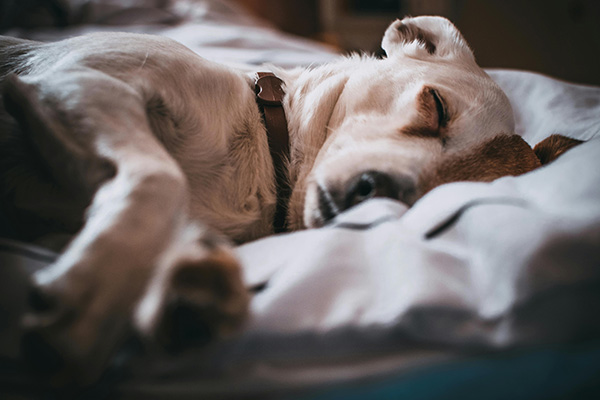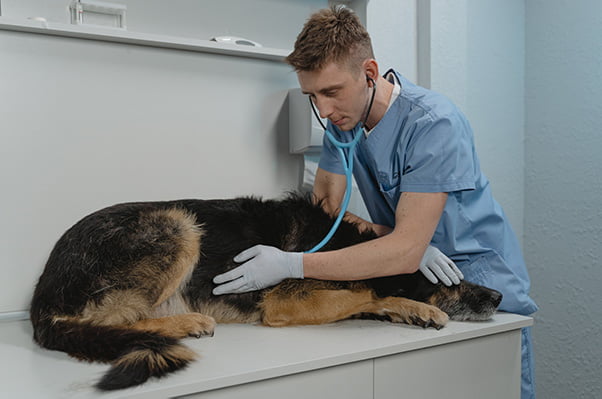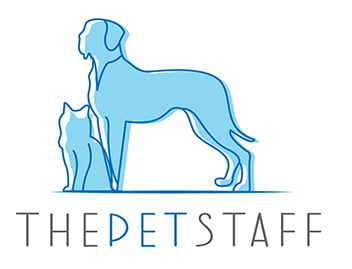As a dog owner, you probably stay on top of your pet’s health with routine vet checkups, a nutritious diet, and regular exercise. But sometimes, unexpected medical emergencies can arise—ones that need urgent care and could be life-threatening. One serious example is bloat, or gastric dilatation-volvulus (GDV). This condition is extremely painful and, without immediate treatment, can be fatal. In this blog, we’ll dive deep into what bloat is, its causes, symptoms, how bloat is treated, and how you can protect your dog from this dangerous condition.
What is Bloat in Dogs?
Bloat in dogs happens when the stomach becomes distended due to a buildup of gas, food, or liquid. This condition, known as gastric dilatation, can progress to volvulus, where the stomach twists on itself. When this happens, blood flow to the stomach and surrounding organs is restricted, leading to tissue death, shock, and even death if not treated immediately.
There are two forms of bloat:
Simple Bloat: The stomach fills with gas or fluid but does not twist. While still dangerous, this form is less severe than GDV.
Gastric Dilatation-Volvulus (GDV): The stomach twists, trapping its contents and cutting off blood flow. It’s a critical condition that demands prompt surgical intervention.
When a dog’s stomach fills with gas, it can press against the diaphragm, making it hard for the dog to breathe. If the stomach twists, it traps the gas and prevents it from escaping. This twisting also compresses major blood vessels, leading to a drop in blood pressure and damage to vital organs like the spleen and pancreas. Without prompt treatment, GDV can be fatal within hours.
Risk Factors for Bloat

While any dog can develop bloat, certain factors increase the risk:
High-Risk Breeds
Deep-chested dogs, large and giant-breed dogs, are most susceptible to bloat. Great Danes have the highest risk, followed by German Shepherds, Standard Poodles, Doberman Pinschers, Weimaraners, Irish Setters, Saint Bernards, Boxers, and even Basset Hounds, due to their unique body structure. Mixed-breed dogs with deep chests may also be at risk.
Genetic Factors
A family history of bloat increases risk, suggesting a hereditary component. Older dogs (7+ years) are more vulnerable, as are underweight or lean dogs. Fast eaters, who swallow excess air, and dogs fed only one large meal per day face a higher risk of health issues than those fed multiple small meals.
Feeding Habits
Dogs that only eat dry food diets high in fat or oil may be at risk of bloat, although research is mixed. Raised food bowls, once recommended, may actually increase risk. Consuming large amounts of water right after eating or engaging in physical activity too close to mealtime can also contribute to a bloated stomach.
Behavioral and Environmental Triggers
Stressful situations (like boarding or car rides after meals) may contribute. Dogs that gulp air due to rapid eating are at higher risk, as are those with a previous bloat episode, since recurrence is possible.
Symptoms of Bloat
Identifying the early signs of bloat is vital for prompt treatment. The symptoms tend to come on quickly and may include:
A bloated or swollen stomach that appears swollen and tight when touched.
Unproductive retching or attempts to vomit without bringing anything up.
Excessive drooling or panting.
Restlessness or signs of discomfort, such as pacing or inability to lie down.
A fast heart rate and pale gums can be signs of inadequate blood circulation.
Collapse or symptoms of shock, including extreme weakness or lethargy.
If you observe any of these signs, taking immediate action is crucial, as this is a veterinary emergency. Bloat is a race against time, and every minute counts. Note that the survival rate for dogs with GDV depends on how quickly they receive prompt treatment. With timely veterinary medicine intervention, the survival rate is around 80%. However, complications such as organ damage, infection, or the release of toxic hormones can occur, making post-operative care critical. Senior dogs and those with a history of bloat in their family may face a higher risk of complications.
Diagnosis
Veterinarians diagnose bloat (gastric dilatation-volvulus or GDV) in dogs through a rapid, multi-step process due to the condition's life-threatening nature. The diagnostic approach begins with a thorough physical examination where the vet checks for hallmark signs, including a distended, firm abdomen and unproductive retching attempts. They also assess for shock symptoms, such as a rapid heart rate, pale gums, and labored breathing, which indicate poor circulation due to the twisted stomach.
Imaging tests provide definitive confirmation, with abdominal X-rays being the gold standard. These typically reveal the characteristic "double bubble" appearance of a twisted, gas-filled stomach. If X-rays prove inconclusive, an ultrasound may be performed to evaluate blood flow and organ positioning. Concurrently, blood work helps assess the dog's overall condition, with lactate levels serving as a key indicator of tissue damage from oxygen deprivation, and an ECG monitoring for potentially fatal heart arrhythmias that often accompany GDV.
Treatments For Bloat In Dogs

Emergency Stabilization
The first and most critical step in treating bloat (GDV) is emergency stabilization. Upon arrival at the veterinary clinic, the medical team immediately administers intravenous (IV) fluids to combat shock and restore blood pressure. Oxygen therapy may be provided if the dog shows signs of respiratory distress. Pain management is initiated with strong analgesics, typically opioids, to alleviate discomfort. Broad-spectrum antibiotics are given intravenously to prevent sepsis, as the twisted stomach can lead to bacterial translocation and systemic infection. The veterinary team also monitors the dog's heart rhythm closely, as GDV often causes dangerous arrhythmias that may require additional medication.
Stomach Decompression
Once the dog is stabilized, the next priority is relieving pressure in the distended stomach. Veterinarians first attempt orogastric intubation, passing a tube through the mouth into the stomach to release trapped gas and fluid. However, if the stomach has twisted (volvulus), the tube may not pass through the obstruction. In such cases, emergency trocar decompression is performed by inserting a large-bore needle or catheter directly through the abdominal wall into the stomach to release gas. While these procedures provide temporary relief, they are not definitive treatments and serve only as life-saving measures until surgery can be performed.
Emergency Surgery
Surgical intervention is the only definitive treatment for GDV and must be performed as quickly as possible. The surgeon makes an abdominal incision to access the stomach, carefully untwists it, and evaluates the tissue for viability. Any necrotic (dead) portions of the stomach wall must be removed. The spleen is also examined, as it often becomes engorged and may require partial or complete removal. The key aspect of the procedure is a gastropexy, in which the stomach is permanently attached to the abdominal wall to prevent future twisting. This step is vital as dogs that survive GDV without gastropexy have a high risk of recurrence.
Post-Operative Care
Following surgery, intensive postoperative care is essential for recovery. Dogs typically remain hospitalized for 24-72 hours for continuous monitoring. IV fluids and antibiotics are continued, and pain management is carefully maintained. Food is reintroduced gradually, starting with small amounts of bland, easily digestible meals. Strict activity restriction is enforced for 2-4 weeks to allow the abdominal incision and gastropexy site to heal properly. Follow-up visits are essential to track the healing progress and identify any potential complications. With prompt treatment, including surgery within the first few hours of symptoms, survival rates range from 75-90%. Dogs that undergo a gastropexy have less than a 5% chance of recurrence, making this procedure highly recommended for breeds at risk.
Prevention of Bloat In Dogs
Although bloat cannot always be prevented, there are measures you can take to lower your dog’s risk:
Feeding & Diet Management
Adopting proper feeding habits is the first step in preventing bloat. Instead of one large daily meal, divide your dog's food into two or three smaller portions served throughout the day. Invest in a slow-feed bowl designed with ridges or mazes to prevent your dog from gulping food too quickly. Contrary to previous beliefs, recent studies suggest elevated food bowls may actually increase bloat risk in some breeds, so use ground-level bowls unless your veterinarian specifically recommends raised feeders. When feeding dry kibble, consider adding a small amount of water or canned food to help reduce air swallowing. Always monitor water intake after meals, allowing small, frequent drinks rather than letting your dog consume large amounts at once.
Exercise & Activity Restrictions
Timing physical activity around meals is crucial for bloat prevention. Establish a routine where your dog rests for at least one hour before eating and remains calm for two hours after meals. Avoid vigorous play, running, or stressful situations during these critical periods. If you have more than one dog, feed them separately to avoid competition for food. Be particularly cautious with deep-chested breeds that tend to be more active - even excited greeting behaviors or jumping after meals should be discouraged. Structured, leash-controlled walks for bathroom breaks are preferable to free running during digestion periods.
Preventative Surgery (Gastropexy)
For high-risk breeds, prophylactic gastropexy offers the most reliable protection against fatal stomach twisting. This surgical procedure permanently attaches the stomach wall to the abdominal cavity, preventing rotation while still allowing normal stomach function. Many veterinarians recommend performing gastropexy during spay/neuter procedures in adolescent giant breeds. The laparoscopic (keyhole) method has made this preventive surgery less invasive, leading to quicker recovery times. While gastropexy doesn't prevent stomach dilation, it eliminates the life-threatening torsion component of GDV, reducing mortality risk by over 95% in susceptible dogs.
Know the Risk Factors & Monitor
Understanding your dog's individual risk profile enhances prevention efforts. Research your dog's lineage when possible, as bloat tends to run in families. Be extra vigilant with deep-chested breeds and older dogs (seven years or older). Learn to recognize early warning signs like pacing, excessive drooling, or repeated unsuccessful attempts to vomit. Keep emergency veterinary contacts readily available and know the fastest route to your nearest 24-hour animal hospital. Consider keeping a canine first aid kit with a trocar needle if you live far from emergency services, but use it only with proper veterinary instruction.
Stress Reduction
Managing your dog's stress levels forms an often-overlooked aspect of bloat prevention. Create a peaceful feeding environment away from household chaos or other pets. Establish consistent mealtime routines to prevent anxiety-related gulping. Avoid scheduling meals immediately before potentially stressful events like car rides, grooming appointments, or veterinary visits. For dogs prone to separation anxiety, consider using puzzle feeders rather than leaving large meals before departures. In multi-dog households, feed dogs separately to eliminate competition stress that can lead to rapid eating.
